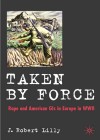Taken By Force: Rape and American GIs in Europe during World War II
Written by: J Robert Lilly,
Palgrave Macmillan, Basingstoke, 2007,
ISBN: 9780230506473, 272 pp.
Reviewed by: Narelle Biedermann
Reading a book that discusses rape so confrontingly and transparently in any context makes for a challenging and often difficult read. Sociologist and academic J. Robert Lilly sets himself an extraordinary task to make this unpalatable and highly sensitive topic approachable, and surprisingly, manages to do this reasonably well.
The central text of the book is hidden behind twenty-one introductory pages consisting of an acknowledgement, preface to both the French and English editions, and a foreword. The inclusion of such an extended and detracted series of additions was extremely frustrating and self-indulgent in places. The author of the French preface goes to extremes to point out that this book was selected for the French market before being accepted in the US market because of American distaste towards negative stories relating to the US military. Indeed, Lilly himself comments that his goal was not to tarnish the wartime contributions of more than 16 million GIs who served in the armed forces during the Second World War. Nevertheless, he argues that this story still needed to be told because the collective memory of the Second World War neglects the conflict’s rotten underbelly. War is never pure and clean. It involves murder, sexual violence, torture, and a whole host of acts deplored by most civilised societies. And yet the collective memories of war tend not to include such acts.
The book sets out to explore patterns of rapes committed by US servicemen across the European theatre of operations in the Second World War and the Army’s responses to these crimes. It begins with the presence of US military personnel in the United Kingdom, before moving to France and Germany. In each of these theatres, Lilly explores the who, what, where, when and why of rape, drawing on court records and anecdotal evidence to attach a human face to the perpetrator. His analysis provides several interpretations of rape in war: cultural/genocidal weapon; form of male communication; part of the military culture; revenge and elevated masculinity; part of the ‘rules’ of war; sexual comfort; strategy; ‘imperial right’; and gratuitous/ random behaviour. However, it is unfortunate that the consequences for the victims were explored in broad-brush means. Perhaps this is indicative of the ways female victims of rape and other violent crimes in warfare are viewed as an afterthought or an unfortunate by-product. Indeed, rape during wartime was not considered a crime against humanity until 1946; prior to this time, it was an ancillary subject of international and military law.
The work is extensively researched and referenced, making pursuing further reading in this area possible. Court records, newspaper articles and US Judge Advocate General trial transcripts serve to provide rich, detailed and objective analysis. Reflecting the racial segregation prevalent in Second World War America, Lilly’s analysis highlights the extant racial division of military justice, particularly in relation to the discrepancies in punishment between black and white perpetrators.
This would be a useful book to include as part of ethical discussions of warfare, military culture, and social behaviour. While general military history tends to ignore the reality that rape committed by military personnel has happened, Lilly holds no reservations to name and shame. Early in the Foreword, Dr Peter Schrijvers from UNSW notes that ‘rape in war and conflict is of all times and all armies’ and to assume otherwise is both foolish and ignorant.

